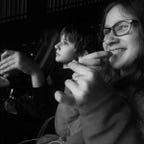Elevated visions: Bernini and the Roman Baroque: Masterpieces from the Palazzo Chigi in Ariccia at the William King Museum of Art
As the title of this delightful exhibit proclaims, it tells multiple stories: stories of an age, a city, a family, and an artist. But the initial welcome of the William King Museum of Art set the tone for my visit with two classes (Humanities I and Europe 1789–1914) last week. The drive up the hill to the WKMA always gives me a feeling of anticipation; something special awaits. We were greeted personally by Director Betsy White, and she and other museum staff engaged students in conversation afterwards. The WKMA’s motto may be “Never the Same Museum” thanks to its rotating exhibits, but in one respect it is solidly unchanging: this is a friendly, vibrant center for the arts. I would add, on a personal note, that the WKMA has welcomed Kathleen and Peter for many years, both to exhibits and workshops, and they have always been treated with dignity, warmth, and inclusion. This is a special place, and this is a special exhibit.
The exhibit itself begins with the Chigi (rhymes with squeegee) family and the collection they assembled in the mid-seventeenth century at their palazzo near Rome. We are greeted with symbols of the family’s status: leather wall covering and silk damask, as well as the frame on the painting of Summer, bearing the Chigi crest (six mountains with a star). This crest could be combined with acorns and oak leaves representing their close connection, a century earlier, with the della Rovere family of Pope Julius II. Such symbols, and the opulence of the objects and paintings that follow, reflect a family at the shining apex of its importance. As this collection was assembled, Fabio Chigi was elevated to the papacy as Alexander VII, and he appointed his nephew Flavio as cardinal-nephew. (The habit of appointing a nephew to the cardinalate was ancient, and it gave rise to the word nepotism, as the Latin for nephew is nepos.) Flavio was responsible for Palazzo Ariccia, and a magnificent portrait of him welcomes you to the first room.
The Chigis’ taste reflects their age. This exhibit immerses viewers in the Baroque, its more-is-more aesthetic expressed in paintings and objects alike. This is immediately evident in adornment, with most of the spare space in the paintings filled with putti (cherubs) and flowers. Hints of the northern Baroque also find their way in, particularly the dramatic expression of light through dark surroundings, chiaroscuro, notable particularly in the Nativity in the second room. The calm balance of the Renaissance gives way here to movement and emotion and passion, hence the (initially insulting) label baroque, an irregular pearl. But the subject matter stayed the same, a mix of classical and biblical scenes meant, in the curator’s words, to “elevate the viewer.” In this exhibit we find Orpheus and Euridice, the arming of Aeneas by Venus, and a massive Bacchus; we also find Hagar and Ishmael being fed by an angel, a striking St Andrew with his saltire cross, and two images of Lot and his daughters. (That subject, bizarrely popular in the seventeenth century, seems either to have been a morality tale or just kind of racy.)
These paintings take us outside our own time and place, elevate us in several cases to the heavens, surrounded by putti and light. Above the generous lawyer St Ivo (Yves), for example, curtains in the sky are pulled back to show the approval of Christ; St Joseph enters glory; two ceiling designs show us a world beyond our vision. But there is also a nod to the Baroque age’s interest in the science of vision, in a design for an illusory dome by Andrea Pozzo. With his remarkable grasp of perspective, Pozzo painted a flat ceiling with such skill that visitors to the church of St Ignazio still believe it has a dome at first glance.
Alexander VII had another vision, a Rome redesigned according to the principle of “urban theatre.” Bernini was his artist of choice, and their mutual labors display the Baroque to the world. A microcosm of this urban vision appears here, with etchings of Palazzo Ariccia displaying Bernini’s architectural ideals, and a central hanging lamp giving us a hint of his unsurpassed sculptural design. The palazzo itself was several miles south of Rome, but its aesthetic was thoroughly that of the pope and his favorite artist.
For all the public grandeur of this exhibit, its centerpiece is intensely personal, a window on Bernini’s profound faith. His Sanguis Christi shows both deep piety and mystical vision, in strikingly modern fashion. Here is a crucifixion, viewed not from the front but at an angle, and floating in mid-air. Beneath the cross stretches a sea of Christ’s blood, continuing to pour from the five wounds eternally, with Mary holding it up to God the Father. The image is still Baroque, and naturally there are putti present, but the adornment is swallowed by the effect of the whole. The sea of blood is not gory, but inexhaustible, a reflection perhaps of Bernini’s daily attendance at Mass, and his reception of the sacrament twice a week. Bernini kept this image by his bedside, and etched it for printing, so that it was never confined to a palazzo or even a city, but could be meditated on by the world.
This exhibition, similarly, offers the beauties of the Baroque freely to our region, for which I am immensely grateful. Thank you to all those who made this possible, especially to my friend Rose Marie Burriss. This is an exceptional collection, and it is a marvel that the WKMA got it to Abingdon. Do yourself a favor: step into the world of seventeenth-century Italy, spend time with the Chigis, enjoy the lavish ornamentation and technical brilliance of Baroque art, and meditate for a moment with Bernini. You’ll truly be elevated.
